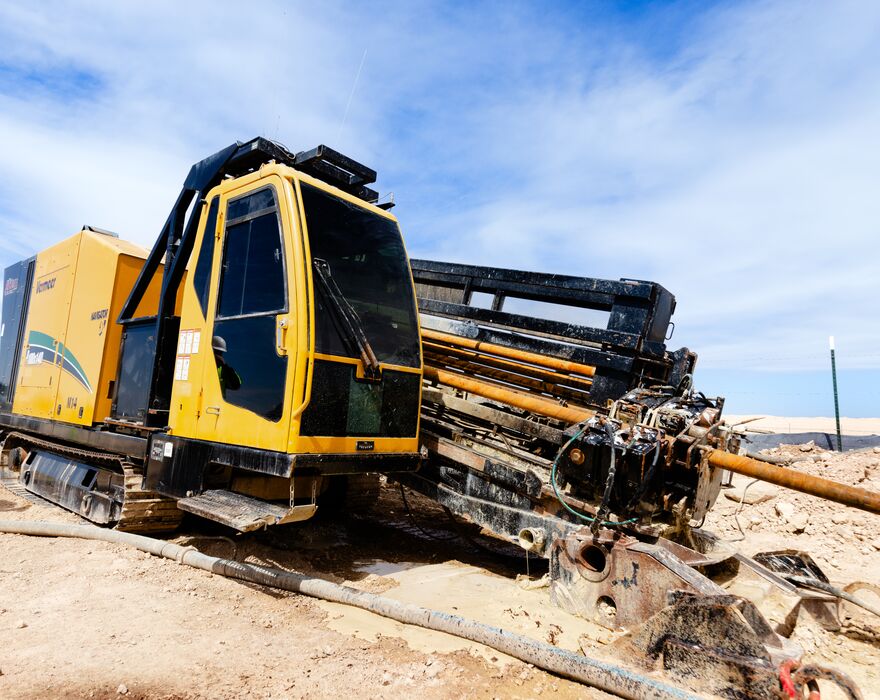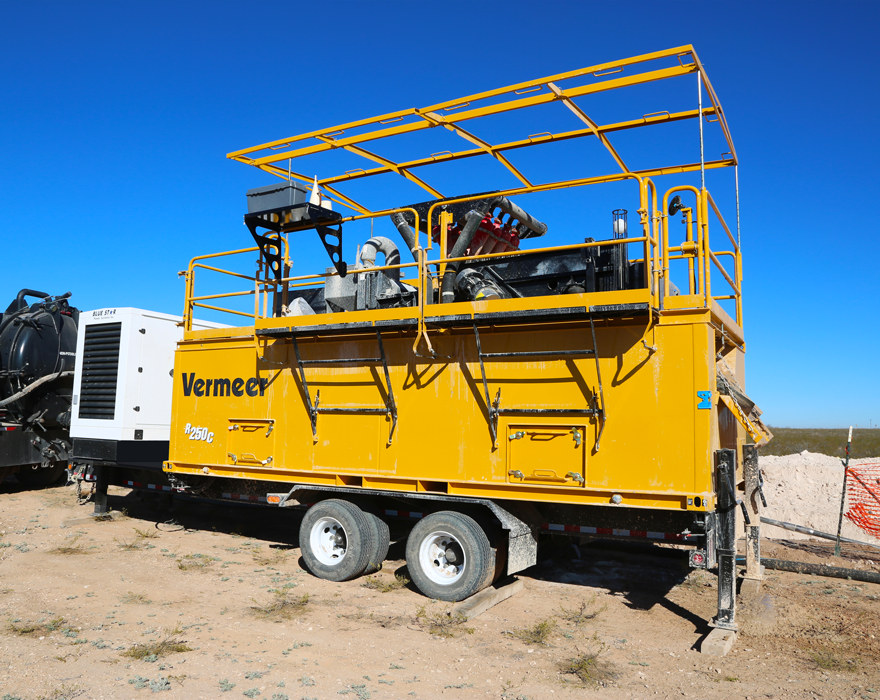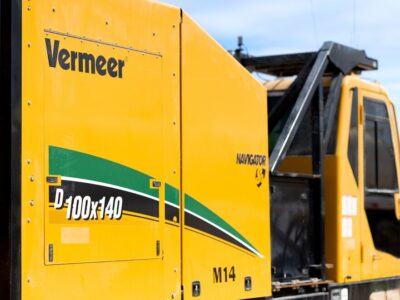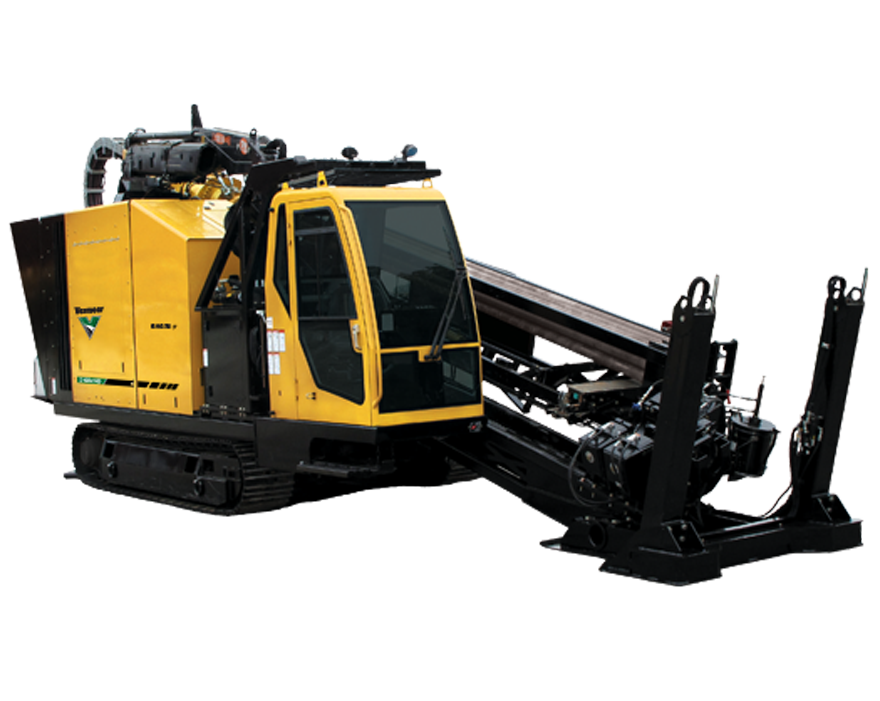Marv Klein, an application specialist for pipeline products has worked at Vermeer for just over 25 years. He has witnessed the horizontal directional drilling (HDD) industry grow and evolve throughout his career, which means equipment and jobsites have changed as well. Klein specializes in pipeline equipment and aims to support operators on their jobsites to maximize productivity and efficiency.
At Vermeer, utility drills range from 7,850 lb – 60,000 lb (34.9 kN – 266.9 kN) of thrust and are typically used to install a variety of products like fiber, water and telecommunications lines. For pipeline drills, they vary from 100,000 lb – 1,360,000 lb (444.8 kN to 6,049.6 kN) of thrust to install mainly pipeline and gas product. It’s obvious to see there is a clear distinction in drill power and capabilities between utility and pipeline drills.
A particularly unique solution to tackle both pipeline and utility jobs is the D100x140 S3 horizontal directional drill. It’s designed to produce robust power for pipeline applications, while maintaining a compact footprint to be used for utility work or on jobsites with restricted space. See what makes this drill a versatile asset to HDD operators who find themselves installing a variety of products.
How to evaluate jobsite equipment needs
Before you step onto a jobsite, you want to feel confident that the equipment you bring will successfully complete the installation, while being as productive and cost efficient as possible.
The first step to determining what equipment your jobsite will require is to get the full scope of the project. This will include the product being installed, the layout or size of the jobsite and your budget for that project.
After that, operators need to feel confident that the drill they’re using has enough rotational torque and pullback power to install the desired product. “(The D100x140 S3) has substantially high torque for such a small drill, and that’s what really makes it attractive for a lot of contractors and using it in a lot of different projects where they typically may want to bring in a bigger rig to get the job done a little quicker,” Klein explained. “But when they’re looking at that job and evaluating what the right choice is or what equipment to use, there other things that factor into that — and its right-of-way space.”
When it comes to evaluating the cost of operation, it typically increases as the size of your drill gets larger. This is primarily due to needing additional equipment and crew members to support a drill of a larger size. So, if you’re working on a job that requires a robust, powerful drill but you want to try and keep costs as low as possible, a drill like the D100x140 could be an asset to your fleet.
What makes this drill stand out in the HDD industry?
The D100x140 S3 is a unique machine in the HDD market. It’s not only used for oil, gas or other large pipeline projects — but utility projects as well due to the machine’s small footprint. “We’re starting to see a lot more contractors trying to diversify their business and their companies to try to branch out into other markets,” Klein said. “The D100x140, because of the power that it has in a small footprint, it’s a very good choice to work in a lot of different markets such as telecom and municipality work.”

Being a self-contained horizontal directional drilling machine also helps with transportation to and from your jobsites. The D100x140 S3 is also designed with an onboard high-pressure mud pump, onboard drillers cabin and an onboard rodbox to house several pieces of your drill string. With the D100x140 S3, the jobsite setup will often be less time-consuming when compared to other large drills with a more modular setup.
Another perk is that the D100x140 S3 was built to be as lightweight as possible and does not require special permitting in most situations. Most drills with similar capabilities to the D100x140 S3 are heavier and often do require additional permits to haul a heavier load. With modular drills, you will likely have to haul multiple loads with the cab, mud pump or mounting base anchor when you move to and from jobsites. This could mean potentially three separate loads of equipment compared to a single load with the D100x140 S3.
Where jobsites can be particularly narrow, like in residential areas or right-of-ways, the D100x140 S3 excels. Klein recalled an operator who was installing an electrical conduit through a busy highway. Due to the volume of traffic, one of the jobsite requirements was that the equipment had to be removed every evening. With that requirement, the jobsite logistics and transportation had the potential to become extremely inconvenient. Thanks to the design of the D100x140 S3 and R250C reclaimer, moving and setting up the jobsite every day was much simpler.
R250C reclaimer
When engineers were designing the R250C, they wanted to make it compact yet powerful to tackle larger installation projects. The R250C is intended to be the ideal choice for contractors who work in narrow right-of-ways or limited space for jobsite set up.
This reclaimer is built with a single-trailer tow away design to be easily moved and attached to the drill on the jobsite. The R250C was built with volume and mud pump capabilities specifically to complement the D100x140, making it an ideal choice for support equipment.

Team members at Vermeer have worked diligently to create a powerful, feature-rich machine to help you complete the work ahead — no matter what the job requires. If you find yourself working with a variety of products and in narrow spaces regularly, you may consider adding a D100x140 and R250C to your fleet.
To learn more, give your local Vermeer dealer a call today.
Vermeer Corporation reserves the right to make changes in engineering, design and specifications; add improvements; or discontinue manufacturing at any time without notice or obligation. Equipment shown is for illustrative purposes only and may display optional accessories or components specific to their global region. Please contact your local Vermeer dealer for more information on machine specifications.
Vermeer, the Vermeer logo and Equipped to Do More are trademarks of Vermeer Manufacturing Company in the U.S. and/or other countries.
© 2025 Vermeer Corporation. All Rights Reserved.

